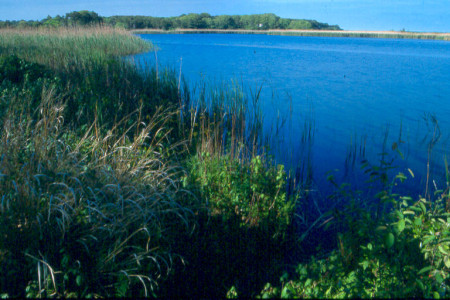Cape Cod Priority Ponds Project
CAPE COD PRIORITY PONDS PROJECT
EXECUTIVE SUMMARY
The Compact Of Cape Cod Conservation Trusts, Inc.
Introduction
This project was undertaken to provide the land trusts and municipal Land Bank committees of Cape Cod with practical information regarding the current status and conservation values associated with the remaining undeveloped land surrounding Cape Cod’s freshwater ponds. The information and maps included in this report are intended to support land conservation activities, as well as provide the impetus for a focused campaign of landowner outreach and education. The desired outcome is to secure protection for as many of the top priority parcels as possible.
This report is the result of a broader effort by The Compact to increase its own operational capacity in order to better serve its member trust organizations by providing strategic planning information designed to assist in project selection, evaluation and decision-making. Other recent projects completed as part of this effort include a comprehensive assessment of wildlife habitats on Cape Cod and a series of parcel evaluations for the towns of Brewster, Chatham, Harwich and Orleans that identify and rank priority parcels for conservation town-wide and within the Pleasant Bay watershed.
The motivation behind this strategic planning is simple: vacant land on Cape Cod continues to disappear at an alarming rate and the funding available for open space preservation is sufficient to acquire only a small amount (10-15%) of the remaining undeveloped land. Thus there is an urgent need to act quickly and with focused intent to ensure protection of the most important lands for conservation. This is particularly true for the remaining developable land surrounding the Cape’s freshwater ponds. Waterfront property has always been in high demand on Cape Cod and freshwater ponds have not escaped the impacts of development. The result is predictable, loss of open space and scenic character, reduced habitat value and all too often, impaired water quality.
Freshwater ponds may well represent the next “Gold Coast” of Cape Cod for the 21st century. The term is an apt one. Vacant oceanfront properties are virtually extinct and the price tag for what little remains is extraordinarily high. Naturally, the search for waterfront has shifted inland to the ponds. Even here supply lags behind demand and pond-front properties routinely command values two to three times the similarly sized non-pond-front properties. Because they are relatively rare and highly desired, these properties tend to maintain their value, even during prolonged downturns in the market. This means development pressures will likely remain high and the supply will continue to dwindle, exacerbating the problem and putting properties further out of reach for conservation.
This trend should signal a call to action for conservationists. It is not too late to protect some of the most important remaining priority pond parcels. Indeed, several of the top ranked parcels have already been protected during the course of this investigation. Large tracts around Santuit Pond in Barnstable and Mashpee, Sheep and Long Ponds in Brewster, and Lawrence and Shawme Ponds in Sandwich are now part of the open space legacy of Cape Cod. These are outstanding success stories and demonstrate the continued vision and willingness of Cape Codders to protect what is special about their home. But there is much more to be done. This report identifies nearly 3,000 properties, each with some merit worth examining for protecting pond water quality, wildlife habitat, recreation or public access. This guide is a starting point for taking a comprehensive look at our freshwater ponds and deciding what can and should be preserved.
Goal
The primary goal of the project is to assist in the protection of the most important remaining undeveloped pond shore areas on Cape Cod for water quality, habitat conservation and passive recreation purposes.
Objectives
* To identify, map and rank all the remaining pond shore parcels on Cape Cod (both undeveloped and under-developed)
* To provide a digital database containing maps and a parcel-specific database to support ongoing land protection and water quality monitoring activities.
* To conduct targeted outreach for landowners controlling priority parcels to provide information on land values and identify protection options.
* To develop protection strategies for the top priority properties, particularly those surrounding Great Ponds and Coastal Plain Ponds.
* To further cooperation among the Commonwealth’s environmental agencies, town Land Bank committees, and local non-profit land trusts in protecting the public interest in freshwater ponds.
Summary Of Significant Findings And Results
· 1,029 ponds have been inventoried Cape-wide. Hydrologic information provided by the Cape Cod Commission.
· 170 of these are Great Ponds (over 10 acres in size). 78 Great Ponds are also Coastal Plain ponds.
· Cape Cod has a total of 190 Coastal Plain Ponds that provide important habitat for several state-listed species (Special Concern, Threatened or Endangered) of plants and animals. Please see Appendix 3 for a list of coastal plain ponds.
· 28 ponds in 12 towns are stocked by the Massachusetts Division of Fisheries and Wildlife for recreational trout fishing. See Appendix 4 for list of stocked ponds.
· 60% (615) of the ponds inventoried have further development potential along their shorelines
· Roughly 40% (415) ponds have shorelines that are either completely developed or completely protected.
· 2,404 undeveloped or under-developed pond shore properties were identified for analysis and ranking purposes.
· Falmouth has the highest number of parcels inventoried at 441 (18% of the total) followed by Harwich with 301 (13%), Mashpee with 281 (12%), Brewster with 276 (11%), and Barnstable with 250 or (10%) of the total.
· The top 200 parcels contain approximately 2,800 acres around 81 ponds in 13 towns.
· Sandwich has the most acreage associated with the top 200 parcels with 875 acres, followed by Brewster (482), Barnstable (347), Mashpee (321), Harwich (283), Falmouth (208), Yarmouth, (181). The remaining 133 acres is split nearly evenly by the towns of Chatham, Orleans, Dennis, Truro, Eastham and Provincetown.
· The towns with the highest number of top 200 parcels around ponds are Mashpee (50), Brewster (48), Sandwich (27), Harwich (26), Barnstable (19), and Falmouth (17). The towns of Truro, Yarmouth, Chatham, Dennis, Eastham, Orleans and Provincetown have fewer than five parcels each.
· Roughly 35% (70) of the top 200 parcels are classified as vacant residential land, i.e., state class codes 101, 106 or 109. Nearly 50 % (96) of the top 200 parcels are residential properties larger than two acres containing existing homes or other structures.
· The total assessed value for the top 200 properties in excess of $40 million. Provincetown has the highest assessed value per acre at $131,039. The overall average assessed value per acre is in excess of $42,000 or approximately 55% higher than the average Land Bank per acre price.


